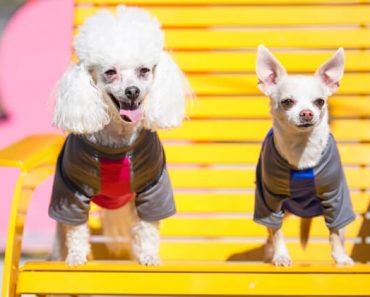As I sit on my couch tapping away at the keys on my laptop, I can’t help but glance down at my feet where my toy Poodle, Gigi, is enjoying an afternoon siesta. But it’s not the snooze itself that I find so adorable. Rather, it’s her twitching paws that mimic running that are stealing my attention. So it has me wondering: Is she dreaming? If so, is she dreaming about the morning run we went on just a few hours ago? Or maybe she’s chasing that bird she just saw out the window! Whatever the case, one look at your sleeping pooch and you may have wondered the same thing.
I recently picked up a copy of the book Do Dogs Deam? by Stanley Coren, a psychologist who studies canines. While there are only a few pages in this amazing book that actually talk about dreaming, the research behind our dogs’ dreams is fascinating! Read on to find out how we know dogs dream, what they dream about, and the signs of a dreaming doggy!
Dogs Dream: The Research
First and foremost, EEG’s tell us that humans, dogs, and even rats dream in a similar way. We all enter into different sleep stages, including that deep sleep with rapid-eye-movement (REM) and irregular breathing. This is the sleep stage where people – along with dogs and rats – are known to experience dreams.
So what the heck are we all dreaming about?
In his book, Coren cites a study out of Massachusetts Institute of Technology (MIT) where rats were trained to run a maze. Researchers first measured brain activities when the rats were awake and actively running the maze, and then again when the rats fell asleep. Their findings? Brain activity during sleep mirrored when the rats were running the maze. And it get’s even more interesting. According to Coren:
“In fact, the wave patterns were so clear that the researchers were able to tell where in the maze the rat would have been if it were awake, and whether it would be moving or standing still.”
Researchers believe, like rats, dogs dream about the activities they participated in earlier that day. But this isn’t the only study to reach such findings.
Inside the brainstem, there is a something that keeps us all from physically acting out our dreams called the Pons. When researchers removed/inactivated this part of a dog’s brain, they found sleeping dogs who entered the dream stage of sleep began to move around.
“During the course of a dream episode, these dogs actually began to execute the actions that they were performing in their dreams.”
And for large dogs and small dogs, their dream episodes are slightly different. Get this — research shows that a small dog, like my toy Poodle and Chihuahua, may dream once every ten minutes. On the flipside, large dogs have longer dreams and may only dream once an hour. #funfact
Signs Your Dog Is Dreaming
For dog parents, it’s pretty easy to determine when our canines are drifting off into dreamland. Some signs include twitching feet, flickering eyes, and maybe even a little whimper or two. This typically happens about 10-20 minutes into a puppy snooze.

Nightmares
Just like we experience all different types of dreams – happy, joyful, sad, and even scary ones – so do our dogs. Some signs that your canine companion is having a nightmare include whimpering, growling, and giving off a general stressed vibe. Most experts say if you suspect your pup is having a bad dream or nightmare not to wake him. Rather, it’s like that old saying, let sleeping dogs lie.








